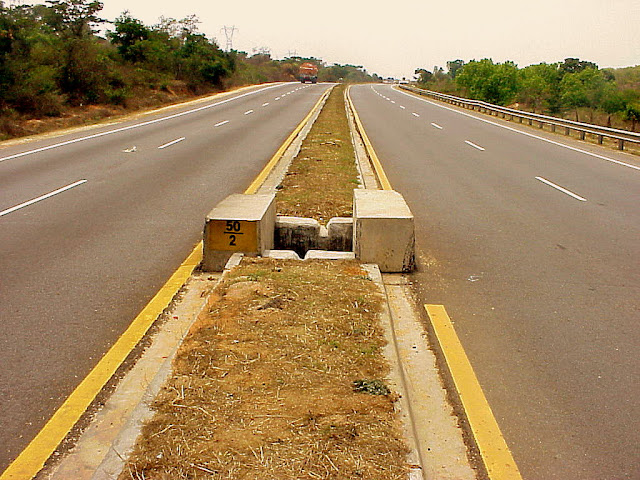Sudhir Gota
Huge number of literature has been generated from around the world showing that an expressway which provides cheap mobility often induces more traffic and thus builds congestion in the network. But, not much research has been carried out on life cycle assessment of such expressways. Three corridors in India and one in VietNam were considered for investigation. The projects were essentially two lanes to four lane conversion projects. The VietnNam corridor was a new expressway project.
The impact has been considered in two stages – short and long term.
a. Short Term: It is incorrect to assume that higher speeds always reduce emissions
It's a myth that higher the speed, lower would be the emission. On the contrary, the emission is lowest when speed is in the range of 40-60 kmph. Lower emissions not only mean better environment but also saving precious fuel. The impact of capacity expansion on corridors during the first 5 years after the improvement after neglecting the induced traffic is shown below.
Project | Scenario | Description (Kilo tons CO2/Km) | ~V/C | Avg Speed (kmph) | ||||
1st Year | 2nd Year | 3rd Year | 4th Year | 5th Year | ||||
Belgaum-Dharwad | BAU | 2.65 | 2.78 | 2.92 | 3.07 | 3.22 | 0.45 | 58 |
After Project | 2.69 | 2.83 | 2.97 | 3.12 | 3.27 | 0.2 | 80 | |
Salem-Namakkal | BAU | 2.28 | 2.39 | 2.51 | 2.63 | 2.77 | 0.4 | 59 |
After Project | 2.32 | 2.43 | 2.55 | 2.67 | 2.81 | 0.2 | 80 | |
Surat-Manor | BAU | 5.959 | 6.452 | 7.434 | 7.962 | 8.107 | 0.85 | 41 |
After Project | 5.415 | 5.842 | 6.327 | 6.659 | 7.213 | 0.4 | 76 | |
Ho Chi Minh -Long Thanh-Dau Giay | BAU | 3.099 | 3.354 | 3.63 | 3.94 | 4.265 | 0.52 | 57 |
After Project | 3.211 | 3.476 | 3.763 | 4.073 | 4.41 | 0.23 | 80 | |
Impact of Road Capacity Expansion in Corridors during Five Years
(excluding induced traffic impact)
It is clear that even during initial years the capacity expansion may not yield CO2 savings. The savings are obtained only in the projects which has existing speed below 40kmph. Increasing the capacity of road which already facilitates speed between 40-60 kmph is iatrogenic. The spur in speed can have disastrous effects on emissions if it exceeds the 40-70 kmph range.
An increase in traffic speed reduces the cost thereby attracting more traffic. Researchers globally have found lane kilometer to have a statistically-significant relationship with VKT. This impact has been quantified in the range of 0.5 to 1. Considering the above criteria and by varying the levels of induced traffic, the emissions were quantified to evaluate the impacts of induced traffic. Using an induced traffic elasticity of 1, the analysis shows that emissions typical national highway in India are higher by over 58% as compared to a scenario which excludes induced traffic considerations. Under varying scenarios of elasticity from 0.25 to 1, the quantified emissions may range from 17 to 58% when tested for 3 different corridors.
An analysis of a typical corridor shows that induced traffic would reduce the initial year savings and would increase the emissions over the project lifecycle.
c. Air quality impacts are highly correlated to CO2 emissions
In case the project provides CO2 reductions there is a huge likelihood that the project may provide similar air quality benefits.
| % Increase with induced traffic ( elasticity 1) | |||
CO2 | PM | Nox | |
Surat Manor | 64 | 76 | 81 |
Salem Namakkal | 80 | 82 | 82 |
d. Construction of expressways make individual travel more efficient
It’s true that expressways due to high induced traffic may increase the emissions when compared with no project scenario. It’s also true that expressways make the individual travel better. Over the project lifetime, it was found that the improvement is in the range of 20-25%. However, more traffic on the road nullifies the benefit and increases the total emissions.
e. Road maintenance can impact the emissions profile of vehicles
By increasing the roughness from 2m/km to 4, 6 and 9 m/km, the emissions (CO2 Tons/Km/Year) increase by 1.6, 3.3 and 5.8% respectively. Thus by following good maintenance strategies, emissions can be reduced to a certain extent by keeping a check on emissions. More insights on impact of roughness can be found here.
f. Construction Emissions should be considered in project analysis
Literature review and subsequent analysis indicated that the construction emissions are a significant fraction of total lifetime emissions. An analysis based on the quantity of construction materials used – cement, steel and bitumen indicates that the approximate emissions of a two lane to four lane improved highway is approximate 1100 tons/km. When all the quantities are considered including the emissions generated by machinery, the emissions range from 2100 to 2400 tons/km for high-speed roads (four-lanes) based on traffic, topography and type of improvements suggested. The operations emissions calculated in the test corridors ranged from 1700 to 7000 tons/km indicating that for high speed roads, (at-grade four-lane highway) construction emissions can range from few months to maximum 2 years of operation emissions.
g. Placeholders
The analysis of three corridors provided the following placeholders
- CO2 Footprint = 1100 Tons/lane-km/Year
- CO2 Savings Indicator = -350 Tons/lane-km/Year ( - ve sign indicates increase in emissions when compared to BAU)
Please click here to read the entire report and access presentations. Comments can be mailed to sudhir(at)cai-asia.org.

